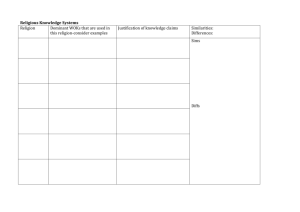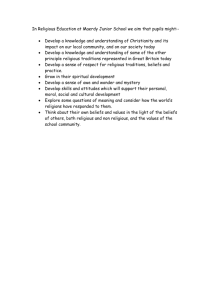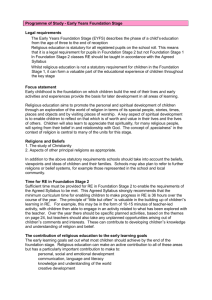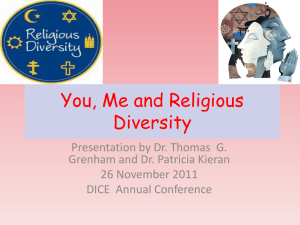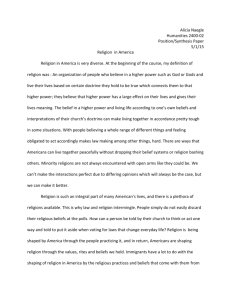religion commitments
advertisement
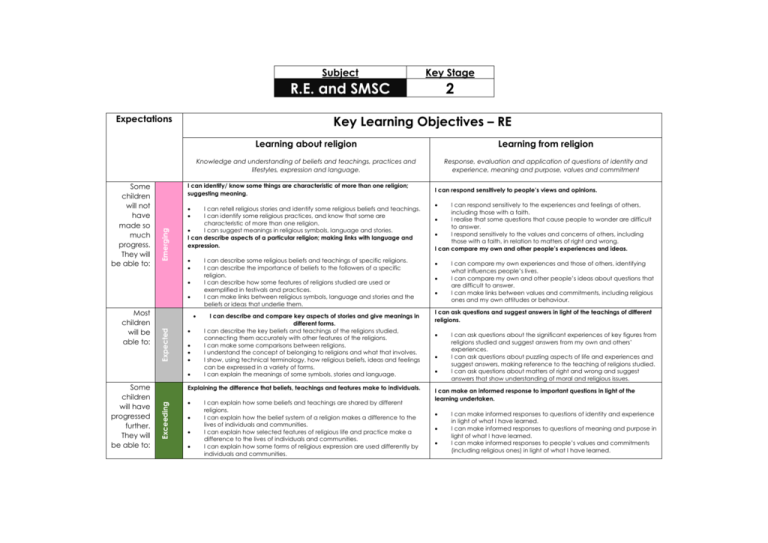
Expectations 2 Learning about religion Learning from religion Knowledge and understanding of beliefs and teachings, practices and lifestyles, expression and language. Response, evaluation and application of questions of identity and experience, meaning and purpose, values and commitment I can retell religious stories and identify some religious beliefs and teachings. I can identify some religious practices, and know that some are characteristic of more than one religion. I can suggest meanings in religious symbols, language and stories. I can describe aspects of a particular religion; making links with language and expression. I can describe some religious beliefs and teachings of specific religions. I can describe the importance of beliefs to the followers of a specific religion. I can describe how some features of religions studied are used or exemplified in festivals and practices. I can make links between religious symbols, language and stories and the beliefs or ideas that underlie them. Expected I can describe and compare key aspects of stories and give meanings in different forms. I can describe the key beliefs and teachings of the religions studied, connecting them accurately with other features of the religions. I can make some comparisons between religions. I understand the concept of belonging to religions and what that involves. I show, using technical terminology, how religious beliefs, ideas and feelings can be expressed in a variety of forms. I can explain the meanings of some symbols, stories and language. Explaining the difference that beliefs, teachings and features make to individuals. Exceeding Some children will have progressed further. They will be able to: R.E. and SMSC Key Learning Objectives – RE Most children will be able to: Key Stage I can identify/ know some things are characteristic of more than one religion; suggesting meaning. Emerging Some children will not have made so much progress. They will be able to: Subject I can explain how some beliefs and teachings are shared by different religions. I can explain how the belief system of a religion makes a difference to the lives of individuals and communities. I can explain how selected features of religious life and practice make a difference to the lives of individuals and communities. I can explain how some forms of religious expression are used differently by individuals and communities. I can respond sensitively to people’s views and opinions. I can respond sensitively to the experiences and feelings of others, including those with a faith. I realise that some questions that cause people to wonder are difficult to answer. I respond sensitively to the values and concerns of others, including those with a faith, in relation to matters of right and wrong. I can compare my own and other people’s experiences and ideas. I can compare my own experiences and those of others, identifying what influences people’s lives. I can compare my own and other people’s ideas about questions that are difficult to answer. I can make links between values and commitments, including religious ones and my own attitudes or behaviour. I can ask questions and suggest answers in light of the teachings of different religions. I can ask questions about the significant experiences of key figures from religions studied and suggest answers from my own and others’ experiences. I can ask questions about puzzling aspects of life and experiences and suggest answers, making reference to the teaching of religions studied. I can ask questions about matters of right and wrong and suggest answers that show understanding of moral and religious issues. I can make an informed response to important questions in light of the learning undertaken. I can make informed responses to questions of identity and experience in light of what I have learned. I can make informed responses to questions of meaning and purpose in light of what I have learned. I can make informed responses to people’s values and commitments (including religious ones) in light of what I have learned. Expectations Subject Key Stage R.E. and SMSC 2 Key Learning Objectives – SMSC ( Social, Moral, Spiritual, Cultural) Spiritual, moral, social and cultural development Some children will have progressed further. They will be able to: Emerging Expected Most children will be able to: Exceeding Some children will not have made so much progress. They will be able to: I am becoming familiar with what ‘spiritual’ means in the religions I study. I can respond to the natural and man - made world with awe and wonder, and show care and respect for my surroundings. I can reflect on the examples set by religious stories and identify how they are relevant to my own life and experiences. I can analyse the moral teaching of founders and leaders, highlight examples of this in daily life and suggest ways I can act on these teachings myself. I can articulate and reflect on my own beliefs and values. I can choose ways to express my beliefs though various artistic forms. I can ask and consider answers to the ultimate questions in life. I can explain the importance of moral codes and key themes in religious stories e.g. confronting evil. I can describe some of the ways in which Britain is a multi-faith, multi-cultural society. I can explore and respect religious traditions and festivals in a range of communities. I understand that there may be more than one side to a moral argument. I understand how different moral codes enable religious communities to work together. I can discuss how people’s beliefs and cultural traditions affect the way they live their lives and their attitudes towards social and environmental issues. Expectations R.E. and SMSC 1 Learning about religion Learning from religion Knowledge and understanding of beliefs and teachings, practices and lifestyles, expression and language. Response, evaluation and application of questions of identity and experience, meaning and purpose, values and commitment I can recount stories and recognise features. I can identify aspects of a particular religion. I can recount outlines of some religious stories. I can recognise some features of religious life and practice. I can recognise some religious symbols and words. I can identify and know that some things are a characteristic of more than one religion. Expected Most children will be able to: Key Stage Key Learning Objectives – RE Emerging Some children will not have made so much progress. They will be able to: Subject I can retell religious stories and identify some religious beliefs and teachings. I can identify some religious practices and know that some are characteristic of more than one religion. I can suggest meanings in religious symbols, language and stories. I can identify aspects of my own experiences and feelings in the religious materials studied. I can identify things that I find puzzling or interesting in the religious materials studied. I can identify what is of value or concern to me, in the religious materials studied. I can respond sensitively to people’s views and opinions. I can respond sensitively to the experiences and feelings of others, including those with a faith. I can realise that some ‘I wonder’ questions are difficult to answer. I can respond sensitively to the values and concerns of others, including those with a faith, in relation to what is right and wrong. I can describe aspects of a religion; making links with language and expression. Exceeding (L5) Some children will have progressed further. They will be able to: I can describe the importance of some religious beliefs and the teachings of religious studies. I can describe how some features of religions are used or exemplified in festivals and practices. I can make links between religious symbols, language and stories and the beliefs or ideas that underlie them. I can compare my own and other people’s experiences and ideas. I can compare aspects of my own experiences with those of others, identifying the effect on people’s lives. I can compare my own and other people’s ideas about questions that are difficult to answer. I can make links between values and commitments including religious ones and my own attitudes or behaviours.
